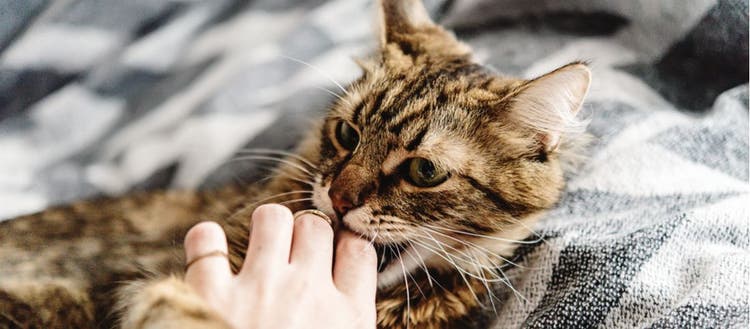
Avoiding Aggression Between Family Cats
Feline aggression can be part of a frustrating pattern of behavior for pet owners, and it can be directed towards humans in the household, as well as household pets. Understanding the underlying cause of the aggression and addressing it early is important in treatment. Overall, 27% of cats surrendered to shelters exhibit aggressive behaviors.
Types of Feline Aggression
There are five categories of aggression in cats:
- Territorial
- Fear
- Pain-Associated
- Play
- Redirected
These categories do not encompass all possible causes of aggression and some cats can have a combination of multiple categories leading to their aggression. Depending on the underlying driving cause of aggression, specific environmental modifications may be helpful in minimizing or eliminating aggression.
First and foremost, if a cat is showing aggressive tendencies towards a person, caution needs to be taken to prevent bites and/or scratches. Children should be kept away from aggressive cats, minimizing interaction as much as possible. If at any point a person suffers from a cat injury, they should seek medical care immediately, since cat bites and scratches can lead to severe and life-threatening infections if left untreated.
Territorial Aggression
This type of aggression is seen in cats that feel like their personal space is being invaded and is commonly seen against other household pets. In this scenario, the aggressor should be put in a separate location where they can have their own bed, litter box, food/water, and toys, wholly separate from other household pets. Over time, you can introduce the aggressor and the offending pet into the same space in carriers or on leashes/harnesses. This time period needs to be a positive experience for both pets, and each animal needs to be given food or treats in their own space. Slowly, their food bowls can be moved closer. If at any point a confrontation breaks out, the cats need to be separated and the process starts again. It can take weeks to months before they share the same space without territorial actions. The goal is for the aggressor cat to realize that they do not need to compete for resources and that they can share a combined space with another animal and still receive equal resources.
Fear Aggression
This is frequently seen in feral cats or those with limited socialization. These animals fear humans and domesticated cats, due to this fear, they act defensively and attack. Time and patience are key for these animals. Do not force love or physical interaction upon them, since it will only make their fear worse. Food and treats are the way to their hearts, especially if they have been feral. Over time, they will associate people with food and transition from feelings of fear to trust. Provide them with food slowly and at a distance, backing away and allowing them to approach the bowl on their own terms. You can pull the bowl closer to you or stay in the room while they eat once they become comfortable. If done at their pace, they will adjust to food-based interactions and hopefully begin to seek attention and affection.
Pain-Associated Aggression
All animals can react aggressively if in pain. Working with a veterinarian to determine their source of pain and begin pain management is important. Some cats with arthritis may even react aggressively to being touched or picked up.
Play Aggression
Play aggression is when fun time escalates to aggression. This is commonly seen in bottle-raised kittens and cats that were not raised by a mother cat and littermates. When they are growing and learning, they are taught not to bite hard or scratch when playing. Cats that missed these elementary lessons often escalate to attacking during playtime. Keys to minimizing this activity is to prevent fingers from being used as play toys. People love to dangle their fingers in front of cats, which are then perceived as play-appropriate toys to attack and bite. Toys, such as wands, are helpful to distance your hands from a cat during play time. Also, noting a cat’s behavior when they switch from play mode to attack mode and stopping play or redirecting with a toy is extremely useful. Laser pointers are also helpful in directing a cat’s energies away from the object of aggression.
Redirected Aggression
This is a type of aggression that stems from uncomfortable situations and stimuli, like loud noises. The key to preventing this type of aggression is identifying the types of stimuli that trigger it and avoiding them.
Tips for Solving Aggression Issues Between Household Cats
Here are general tips for dealing with feline aggression:
- Spay and neuter all cats in your household. Hormones only worsen inter-cat aggression.
- Know your cat’s personality. Some cats prefer to be on their own and don’t want to interact with other household pets.
- Slowly introduce new pets to the household to minimize aggression.
- Never physically discipline an animal. This can induce fear and lead to aggression, not to mention inflict physical and emotional pain.
- Ease feline anxiety by introducing feline pheromones into the household.
- Minimize disturbances to your cat’s schedule and environment. They are creatures of habit.
- Minimize resource fighting. Always provide enough food bowls, water bowls, litter boxes, and sleeping spots. This prevents fighting for resources.
If environmental changes do not halt aggressive behavior, consult with your veterinarian about medication and seeing a veterinary behaviorist.